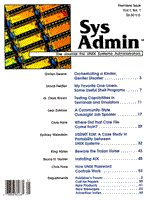
Sidebar: Using Password-ese
The password aging values are defined in this table.
Using this information, and looking at a password that has password aging in place, we can decipher its meaning.
chare:2eLNss48eJ/GY,C2:215:100: Chris Hare:/usr1/chare:/bin/sh
In this example, the password has been set to age using the value of C to define the maximum number of weeks before the password expires, and 2 to define the minimum number of weeks which must pass before the user will be allowed to change his password again.
chare:,..:215:100:Chris Hare: /usr1/chare:/bin/sh
This example will force a password change at the next login.
chare:2eLNss48eJ/GY,./:215:100: Chris Hare:/usr1/chare:/bin/sh
This example will prevent a user from being able to change his password.
|